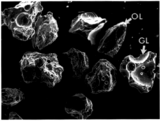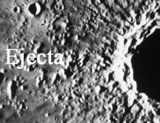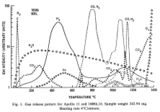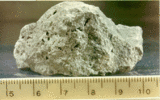Featured Articles
Currently Featured Article
Featured article: JSC-1 | 20 September 2011
JSC-1, a lunar soil simulant, was developed and characterized under the auspices of the NASA Johnson Space Center. This simulant was produced in large quantities to satisfy the requirements of a variety of scientific and engineering investigations. JSC-1 is derived from volcanic ash of basaltic composition, which has been ground, sized, and placed into storage. The simulant's chemical composition, mineralogy, particle size distribution, specific gravity, angle of internal friction, and cohesion have been characterized and fall within the ranges of lunar mare soil samples. ...(read more)
Previously Featured Articles
Help, I've been inofremd and I can't become ignorant.
Featured article: Cratering on the Moon | 02 November 2008
Craters cover the surface of the moon and are the result of hyper-velocity impacts by meteorites. The velocity of meteorites upon impact varies, but is generally between 10 and 40 km/sec. This number is a combination of the ‘approach velocity’ and the ‘escape velocity.’ The approach velocity of objects refers to the velocity of the object with respect to the moon. This varies with the type of object (for example, long period comets generally have a higher approach velocity than short period comets) and the direction with which it approaches the moon (for example, if it approaching the moon ‘head on,’ it will have a higher approach velocity than...(read more)
Featured article: Volatiles | 05 August 2008
The primary resource of value to humans on the Moon is the volatile components found in the regolith. These are all the components that are gases at room temperature. Most of the volatiles have been deposited in the top layers of the Moon's surface by the solar wind over geologic time. A notable exception to this is Argon. the concentration of Argon in lunar soil is much higher than found in the solar wind, so must come from a different source. Especially, the isotope Argon-40. It is presently believed that the Argon-40 comes from radioactive decay of Potassium and/or Krypton deep within the lunar mantle or core(read more)
Featured article: Sintered regolith | 29 June 2008
Sintered regolith falls into the category of ceramic materials as sintering is the process most common to ceramics. When bricks are made from clay on Earth, first the bricks are heated long enough and hot enough to drive out the water. Then the heating is increased to cause partial melting or vitrification which results in the edges of adjacent grains being bonded together once they have cooled. The unmelted particles provide a stable shape and size during the process which involves some shrinkage and a decrease in porosity.
Experiments in radiant heating of regolith simulant have been carried(read more)
Featured article: KREEP | 14 May 2008
KREEP is an acronym used in geochemistry to represent a mixture of K-potassium, REE-rare earth elements, and P-phosphorus. It is not only the main source of these elements on the moon, but also many other trace elements such as uranium, thorium, fluorine, chlorine, and zirconium.
...
So to get alloy ingredients for workable metals, nutrients for agriculture, industrial reagents and much more, special concentrations such as ilmenite and KREEP will play a vital role." - Peter Kokh (read more)











